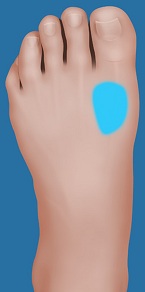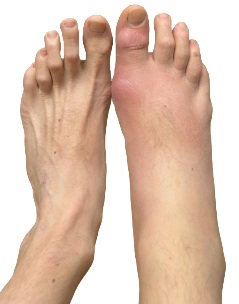Patient Education
-
- Achilles Tendonitis
- Ankle Equinus
- Arthritis of Big Toe joint
- Bunion
- Callus
- Capsulitis
- Flatfoot: Acq'd. PTTD
- Ganglion cysts
- Gouty Arthritis
- Hallux Varus
- Hammertoe deformity
- Ingrown toenails
- Kohler’s Osteochondroses
- Limb Length Inequality
- Metatarsal Arthralgia
- Metatarsal Stress Fracture
- Neuroma - Intermetatarsal
- Pediatric Flat Foot
- Peroneal dislocation
- Peroneal tendon tear
- Plantar Fasciitis
- Plantar Fibroma
- Retrocalcaneal Bursitis
- Sesamoid Fracture
- Shin Splints
- Tarsal Tunnel Syndrome
- Tailor's bunion
- Toenail Fungus
- Warts - Verruca Plantaris
-
- Overview
- Diabetic Shoes
- Shoe Modification
- Accommodative Orthotics
- Ankle Foot Orthosis (AFO) - Overview
- Richie Brace® - AFO
- Dorsiflexory Assist Device (Allard® ToeOFF Brace)
- Gauntlet AFO (Arizona®)
-
- Overview
- Preoperative Care
- Day of Surgery
- Postoperative Care
- Bunionectomy
- Bunionectomy - Post-Op
- Neuroma Surgical Care
- No Barefoot Walking
- Activity Limitations
-
-
-
-
-
Gouty Arthritis
Gout is the most common cause of inflammatory arthritis occurring in adult patients. Gout is considered a mono-articular arthritis that most commonly occurs in the feet. Acute gouty attacks most commonly involve the big toe joint with symptoms including marked pain, swelling and redness to the foot. Occasionally patients experience flu like symptoms which may increase the concern for possible infection.
 Gouty arthritis is more common in men than women. It is more common to find gout occurring in patients with other health problems including diabetes, high blood pressure, obesity and kidney disease. It occurs in approximately 1% of adults over 40 years of age and is most prevalent in men.
Gouty arthritis is more common in men than women. It is more common to find gout occurring in patients with other health problems including diabetes, high blood pressure, obesity and kidney disease. It occurs in approximately 1% of adults over 40 years of age and is most prevalent in men.
Gout is caused by elevated blood levels of uric acid. Uric acid is a breakdown product of the foods that we eat that are typically rich in purines. Some of the purine rich foods that we eat include red wine, nuts, red meat, as well as fish. An over-indulgent diet rich in these foods may be a contributing factor in the development of gout but the liver’s ability to break down purine rich foods as well as the kidney’s ability to eliminate this food byproduct is also key.
Uric acid levels are checked by simple blood tests and generally range between 3.3-6.6dl/mg. As uric acid rises in the blood stream it can turn from a soluble form (diluted) into a crystallized form. The uric acid usually crystallizes in the big toe joint and causes an intense inflammation reaction causing acute pain, warmth and swelling. The diagnosis of gout is based on the presenting symptoms, appropriate evaluation of the uric acid through blood tests--but most importantly by taking a sample of the fluid within the joint. The fluid sample if taken by the treating physician is sent to the laboratory for analysis and identification of the crystals under a microscope. Although, the joint sample is truly the most important test for establishing a diagnosis of gout, the amount of pain that patients are in at the time of their visit makes it difficult for the treating physician to pursue this test.
Although, gouty arthritis is most commonly seen in the big toe joint other joint other joints of the foot and ankle can be involved, making the diagnosis more difficult. Many patients present with symptoms of pain and stiffness to the big toe joint without a history of acute redness or swelling. The limitation of motion of the big toe joint without swelling or redness generally leads to a diagnosis of degenerative arthritis called hallux rigidus.
The treatment of gouty arthritis is different in the acute and chronic phases of the arthritis. The acute pain and inflammation is treated with non-steroidal anti-inflammatory drugs (NSAIDS), steroidal medications, cortisone injections, as well as colchicines. The most commonly used NSAID; Indomethacin is generally taken for the first 7-10days and can be used as a single medication or in combination with other steroidal medication or colchicine. Colchicine in oral form can be very effective in eliminating the acute symptoms of pain but can cause significant gastrointestinal distress including nausea and vomiting. If patients have other serious health concerns including gastrointestinal, kidney or liver disease a cortisone injection may be one of the safest forms of treatment of the acute phase.
When the acute phase has resolved, the crystals in the joint tissue are not fully eliminated which increases the likelihood of future gouty episodes. After the primary acute episode has resolved it is important to identify the uric acid level and focus on non-pharmacologic treatments including a low purine diet and exercise.
In chronic gouty states the gout crystals can build up enough in the joint to create tophaceous gout which when identified in surgery is a material that has a chalky white consistency. By this stage there often are changes of arthritis that can be identified on radiographs.
Diet modifications can help reduce the level of uric acid in the blood stream. Avoiding foods that are high in purines is generally the first step in helping to prevent recurrent gouty attacks. A complete list of purine levels in common foods can be obtained from the American Arthritis Foundation.
Some diuretic medications including hydrochlorothiazide used to treat heart disease decrease the kidney’s ability to eliminate uric acid. If you are on a diuretic you should check with your primary care provider to see if it will effect your uric acid levels.
If dietary changes have not decreased gouty attacks, long term treatment with medications that are designed to help decrease the production of uric acid are indicated. Allopurinol, as well as Uloric is the two most common medications that are used to reduce the uric acid that over time will eliminate the painful occurrence of the gouty attacks. These medications once started are generally taken “life long” based on the need to maintain the uric acid at the required lower levels.
It is important for your treating physician to recognize the importance treating gouty arthritis in its early stages in an attempt to avoid the joint destructive changes that can occur in the late stages of gout. If the arthritis advances to causing chronic pain and joint stiffness surgical arthrodesis (fusion) of the joint may be required to help eliminate the painful arthritis.
Schedule an Appointment

Please call 805.543.7788 for San Luis Obispo, 805.434.2009 for Templeton, or email us to request an appointment.
